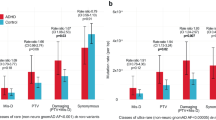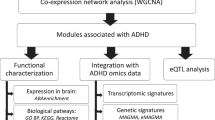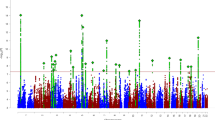Abstract
The DIRAS2 gene is coding for a small Ras GTPase with so far unknown function. In a previous study, we described the association of DIRAS2 rs1412005, as well as a haplotype containing this polymorphism and located in the promoter region of this gene with attention-deficit/hyperactivity disorder (ADHD). In the present study, we searched for rare variants within or near the DIRAS2 gene that might be associated with ADHD using next-generation sequencing. As we were not able to detect any rare variants associated with the disease, we sought to establish a functional role of DIRAS2 rs1412005 on the molecular or systems level. First, we investigated whether it has an influence on gene expression by means of a luciferase-based promoter assay. We could demonstrate that the minor risk allele goes along with the increased expression of the reporter gene. Next, we aimed to identify differences in response inhibition between risk-allele and non-risk allele carriers in children suffering from ADHD and healthy control individuals by analyzing event-related potentials in the electroencephalogram during a Go/NoGo task. Risk-allele carriers showed a changed NoGo anteriorization. Therefore, our results suggest an impact of the investigated polymorphism on the prefrontal response control in children with ADHD. These results imply that the promoter polymorphism is indeed the associated as well as in itself a causal variant. Further research is thus warranted to clarify the mechanisms linking DIRAS2 to ADHD.
Similar content being viewed by others
Log in or create a free account to read this content
Gain free access to this article, as well as selected content from this journal and more on nature.com
or
References
Altmann A, Weber P, Quast C, Rex-Haffner M, Binder EB, Muller-Myhsok B (2011). vipR: variant identification in pooled DNA using R. Bioinformatics 27: i77–i84.
Aron AR, Poldrack RA (2005). The cognitive neuroscience of response inhibition: relevance for genetic research in attention-deficit/hyperactivity disorder. Biol Psychiatry 57: 1285–1292.
Asherson P, Zhou K, Anney RJ, Franke B, Buitelaar J, Ebstein R et al (2008). A high-density SNP linkage scan with 142 combined subtype ADHD sib pairs identifies linkage regions on chromosomes 9 and 16. Mol Psychiatry 13: 514–521.
Azmitia EC (2001). Modern views on an ancient chemical: serotonin effects on cell proliferation, maturation, and apoptosis. Brain Res Bull 56: 413–424.
Cubillo A, Halari R, Smith A, Taylor E, Rubia K (2012). A review of fronto-striatal and fronto-cortical brain abnormalities in children and adults with attention deficit hyperactivity disorder (ADHD) and new evidence for dysfunction in adults with ADHD during motivation and attention. Cortex 48: 194–215.
David M, Dzamba M, Lister D, Ilie L, Brudno M (2011). SHRiMP2: sensitive yet practical SHort Read Mapping. Bioinformatics 27: 1011–1012.
Dickson SP, Wang K, Krantz I, Hakonarson H, Goldstein DB (2010). Rare variants create synthetic genome-wide associations. PLoS Biol 8: e1000294.
Draeger S, Prior M, Sanson A (1986). Visual and auditory attention performance in hyperactive children: competence or compliance. J Abnorm Child Psychol 14: 411–424.
Dresler T, Ehlis A-C, Heinzel S, Renner TJ, Reif A, Baehne CG et al (2010). Dopamine transporter (SLC6A3) genotype impacts neurophysiological correlates of cognitive response control in an adult sample of patients with ADHD. Neuropsychopharmacology 35: 2193–2202.
Fallgatter AJ, Ehlis AC, Rösler M, Strik WK, Blocher D, Herrmann MJ (2005). Diminished prefrontal brain function in adults with psychopathology in childhood related to attention deficit hyperactivity disorder. Psychiatry Res 138: 157–169.
Fallgatter AJ, Ehlis AC, Seifert J, Strik WK, Scheuerpflug P, Zillessen KE et al (2004). Altered response control and anterior cingulate function in attention-deficit/hyperactivity disorder boys. Clin Neurophysiol 115: 973–981.
Faraone SV, Perlis RH, Doyle AE, Smoller JW, Goralnick JJ, Holmgren MA et al (2005). Molecular genetics of attention-deficit/hyperactivity disorder. Biol Psychiatry 57: 1313–1323.
Franke B, Neale BM, Faraone SV (2009). Genome-wide association studies in ADHD. Hum Genet 126: 13–50.
Gizer IR, Ficks C, Waldman ID (2009). Candidate gene studies of ADHD: a meta-analytic review. Hum Genet 126: 51–90.
Gratton G, Coles MGH (1989). Generalization and evaluation of eye-movement correction procedures. J Psychophysiol 3: 1–50.
Halperin JM, Sharma V, Siever LJ, Schwartz ST, Matier K, Wornell G et al (1994). Serotonergic function in aggressive and nonaggressive boys with attention deficit hyperactivity disorder. Am J Psychiatry 151: 243–248.
Jacob CP, Romanos J, Dempfle A, Heine M, Windemuth-Kieselbach C, Kruse A et al (2007). Co-morbidity of adult attention-deficit/hyperactivity disorder with focus on personality traits and related disorders in a tertiary referral center. Eur Arch Psychiatry Clin Neurosci 257: 309–317.
Jasper (1958). Report of the committee on methods of clinical examination in electroencephalography: 1957. Electroencephalogr Clin Neurophysiol 10: 370–375.
Kontani K, Tada M, Ogawa T, Okai T, Saito K, Araki Y et al (2002). Di-Ras, a distinct subgroup of ras family GTPases with unique biochemical properties. J Biol Chem 277: 41070–41078.
Lehmann D, Skrandies W (1980). Reference-free identification of components of checkerboard-evoked multichannel potential fields. Electroencephalogr Clin Neurophysiol 48: 609–621.
Lesch KP, Timmesfeld N, Renner TJ, Halperin R, Roser C, Nguyen TT et al (2008). Molecular genetics of adult ADHD: converging evidence from genome-wide association and extended pedigree linkage studies. J Neural Transm 115: 1573–1585.
Li H, Durbin R (2009). Fast and accurate short read alignment with Burrows-Wheeler transform. Bioinformatics 25: 1754–1760.
Lucki I (1998). The spectrum of behaviors influenced by serotonin. Biol Psychiatry 44: 151–162.
Meldrum C, Doyle MA, Tothill RW (2011). Next-generation sequencing for cancer diagnostics: a practical perspective. Clin Biochem Rev 32: 177–195.
Polanczyk G, de Lima MS, Horta BL, Biederman J, Rohde LA (2007). The worldwide prevalence of ADHD: a systematic review and metaregression analysis. Am J Psychiatry 164: 942–948.
Reif A, Nguyen TT, Weissflog L, Jacob CP, Romanos M, Renner TJ et al (2011). DIRAS2 is associated with adult ADHD, related traits, and co-morbid disorders. Neuropsychopharmacology 36: 2318–2327.
Romanos M, Freitag C, Jacob C, Craig DW, Dempfle A, Nguyen TT et al (2008). Genome-wide linkage analysis of ADHD using high-density SNP arrays: novel loci at 5q13.1 and 14q12. Mol Psychiatry 13: 522–530.
Rosvold HE, Mirsky AF, Sarason I, Bransome ED Jr, Beck LH (1956). A continuous performance test of brain damage. J Consult Psychol 20: 343–350.
Seshadri S, DeStefano AL, Au R, Massaro JM, Beiser AS, Kelly-Hayes M et al (2007). Genetic correlates of brain aging on MRI and cognitive test measures: a genome-wide association and linkage analysis in the Framingham Study. BMC Med Genet 8 (Suppl 1): S15.
Wang K, Li M, Hakonarson H (2010). ANNOVAR: functional annotation of genetic variants from high-throughput sequencing data. Nucleic Acids Res 38: e164.
Wennerberg K, Rossman KL, Der CJ (2005). The Ras superfamily at a glance. J Cell Sci 118 (Part 5): 843–846.
Willcutt EG, Doyle AE, Nigg JT, Faraone SV, Pennington BF (2005). Validity of the executive function theory of attention-deficit/hyperactivity disorder: a meta-analytic review. Biol Psychiatry 57: 1336–1346.
Wray NR, Purcell SM, Visscher PM (2011). Synthetic associations created by rare variants do not explain most GWAS results. PLoS Biol 9: e1000579.
Wylie CJ, Hendricks TJ, Zhang B, Wang L, Lu P, Leahy P et al (2010). Distinct transcriptomes define rostral and caudal serotonin neurons. J Neurosci 30: 670–684.
Acknowledgements
We thank J. Romanos, A. Boreatti-Hümmer, and M. Heine for their dedicated assistance in patient recruitment. I. Reck and M. Rex-Haffner are credited for excellent technical assistance. Finally, we thank all patients, families, and controls for their participation in this study. We thank the German Academic Exchange Service (DAAD) and the University of Bergen for supporting Dr Landaas’ stay in Germany and to thereby enable her to contribute in the DIRAS2 research project.
Author information
Authors and Affiliations
Corresponding author
Additional information
Supplementary Information accompanies the paper on the Neuropsychopharmacology website
Supplementary information
Rights and permissions
About this article
Cite this article
Grünewald, L., Landaas, E., Geissler, J. et al. Functional Impact of An ADHD-Associated DIRAS2 Promoter Polymorphism. Neuropsychopharmacol 41, 3025–3031 (2016). https://doi.org/10.1038/npp.2016.113
Received:
Revised:
Accepted:
Published:
Issue date:
DOI: https://doi.org/10.1038/npp.2016.113



